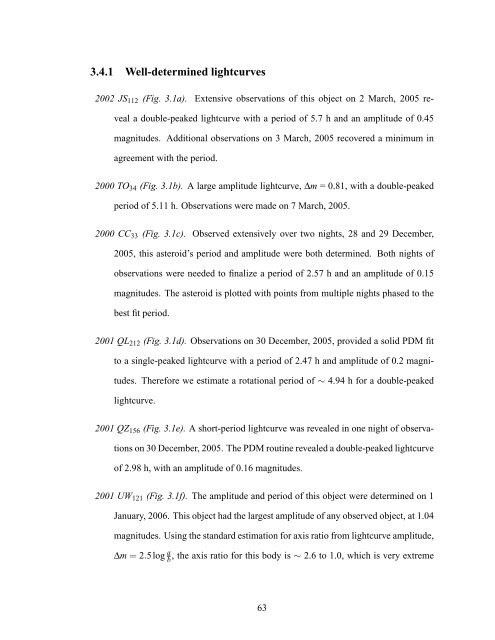Forming Binary Near-Earth Asteroids From Tidal Disruptions
Forming Binary Near-Earth Asteroids From Tidal Disruptions
Forming Binary Near-Earth Asteroids From Tidal Disruptions
You also want an ePaper? Increase the reach of your titles
YUMPU automatically turns print PDFs into web optimized ePapers that Google loves.
3.4.1 Well-determined lightcurves2002 JS 112 (Fig. 3.1a). Extensive observations of this object on 2 March, 2005 reveala double-peaked lightcurve with a period of 5.7 h and an amplitude of 0.45magnitudes. Additional observations on 3 March, 2005 recovered a minimum inagreement with the period.2000 TO 34 (Fig. 3.1b). A large amplitude lightcurve, ∆m = 0.81, with a double-peakedperiod of 5.11 h. Observations were made on 7 March, 2005.2000 CC 33 (Fig. 3.1c). Observed extensively over two nights, 28 and 29 December,2005, this asteroid’s period and amplitude were both determined. Both nights ofobservations were needed to finalize a period of 2.57 h and an amplitude of 0.15magnitudes. The asteroid is plotted with points from multiple nights phased to thebest fit period.2001 QL 212 (Fig. 3.1d). Observations on 30 December, 2005, provided a solid PDM fitto a single-peaked lightcurve with a period of 2.47 h and amplitude of 0.2 magnitudes.Therefore we estimate a rotational period of ∼ 4.94 h for a double-peakedlightcurve.2001 QZ 156 (Fig. 3.1e). A short-period lightcurve was revealed in one night of observationson 30 December, 2005. The PDM routine revealed a double-peaked lightcurveof 2.98 h, with an amplitude of 0.16 magnitudes.2001 UW 121 (Fig. 3.1f). The amplitude and period of this object were determined on 1January, 2006. This object had the largest amplitude of any observed object, at 1.04magnitudes. Using the standard estimation for axis ratio from lightcurve amplitude,∆m = 2.5log a b, the axis ratio for this body is ∼ 2.6 to 1.0, which is very extreme63












